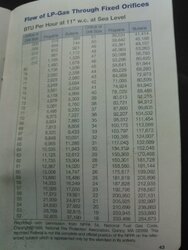My problem is with an 82-year-old Glenwood Duplex, a great old hunk of cast iron, which ran for years on natural gas and has been converted to propane. The top burners are OK. The oven has two speeds: high when it's working to reach temperature and low when it's just maintaining temp. At high, the odor - presumably incomplete combustion - is unbearable.
At low - maintenance - the flame is a good blue throughout; I don't see the yellow tips people talk about with propane. At high, the flame becomes higher (of course) and lazy, and there is a fair amount of what to me is orange - and this is with the air shutter fully open.
There is no plate above the burner - just a solid shelf the full width of the oven interior - so I can't judge flame size in the classic way, but maybe it's too high. There's a serious black deposit on the bottom of that shelf directly above the pilot, so perhaps the pilot assembly needs more cleaning. I've cleaned the burner as best I can.
As a total amateur, all I can think to do is try a smaller orifice. Does that seem reasonable? Or is there another avenue I should be going down?
At low - maintenance - the flame is a good blue throughout; I don't see the yellow tips people talk about with propane. At high, the flame becomes higher (of course) and lazy, and there is a fair amount of what to me is orange - and this is with the air shutter fully open.
There is no plate above the burner - just a solid shelf the full width of the oven interior - so I can't judge flame size in the classic way, but maybe it's too high. There's a serious black deposit on the bottom of that shelf directly above the pilot, so perhaps the pilot assembly needs more cleaning. I've cleaned the burner as best I can.
As a total amateur, all I can think to do is try a smaller orifice. Does that seem reasonable? Or is there another avenue I should be going down?


